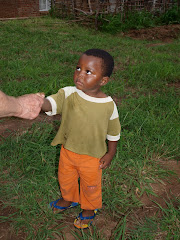Tuesday, February 3rd
-150.jpg) Another participant at the forum meeting had been Jephat, the national director of Hands of Hope. We spent most of Tuesday with Jeph, learning of his vision and the strategy Hands of Hope are following. We saw first-hand evidence of the effectiveness of this program in the eyes of orphans we met that day, and in the joyful response of over two hundred children from a high density city township who had come together for a hot nutritious meal.
Another participant at the forum meeting had been Jephat, the national director of Hands of Hope. We spent most of Tuesday with Jeph, learning of his vision and the strategy Hands of Hope are following. We saw first-hand evidence of the effectiveness of this program in the eyes of orphans we met that day, and in the joyful response of over two hundred children from a high density city township who had come together for a hot nutritious meal.Hands of Hope exists to communicate the love of Christ to orphans by partnering with local churches and assisting the body of Christ in meeting the needs of orphans--body, soul and spirit. The program connects donor churches and organizations in the West with local churches in Zimbabwe in a variety of specific shared response initiatives.
Hands of Hope facilitates these church to church connections in looking after children in distress at every level of their need, setting up and monitoring an atmosphere of care and nurture that is consistently rising to the challenge.
We saw this in action that day. Each participating church has purchased a home in one of the residential suburbs of the city, where house parents and a few staff members nurture and provide for a group of orphans under their care.
As we drove away from one home, after having visited there with a group of older orphan girls, Jeph shared his concern for the need of a half-way house, or vocational center that could serve to prepare sub adult orphans for life outside the protection of the program they had been part of and segue them into the general surrounding population as productive adults.
Jeph also expressed a need for more of a spiritual emphasis in the nurturing of the young people under the care of the various initiatives.
Toward late afternoon, we found ourselves at a feeding station in Highfield, a high density housing community on the edge of the city. This program, carried out under the oversight of Highfield Nazarene Church, offers one hot meal a day (every day of the year) to 200 children from the impoverished community.The children had gathered and were playing as all children do, but with the added expectation of a hot meal which they could clearly see being prepared by a group of women to one side. There, under the protection of a corrugated iron roofed lean-to, a large pot of sadza (a maize-meal staple of the local diet) another one of fresh greens, and a third of stewed dried fish, onions, tomatoes and cabbage were cooking.
-147.jpg) Finally, the children lined up to receive their meal. They folded their hands for a prayer of thanksgiving then moved forward as each was offered a large serving of the hot food. Before receiving the plate of food, however, each child paused to clap his or her hands together (to “ombera”) in the customary expression of gratitude.
Finally, the children lined up to receive their meal. They folded their hands for a prayer of thanksgiving then moved forward as each was offered a large serving of the hot food. Before receiving the plate of food, however, each child paused to clap his or her hands together (to “ombera”) in the customary expression of gratitude.Then, seated in clusters on the ground in the vicinity of the feeding station, they ate and interacted as children everywhere do, with the abandoned joy that comes from a sense of having been cared for.
-148.jpg) One precious little girl had her sandals on backwards, with no apparent impediment to her ability to move around. That picture was too me depictive of a country where things were backwards, but whose people were bravely negotiating the shifting circumstances they encountered day to day.
One precious little girl had her sandals on backwards, with no apparent impediment to her ability to move around. That picture was too me depictive of a country where things were backwards, but whose people were bravely negotiating the shifting circumstances they encountered day to day.





No comments:
Post a Comment